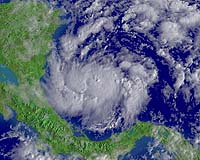| . |  |
. |
San Salvador (AFP) Nov 8, 2009 A late-season hurricane bore down on the oil fields of the Gulf of Mexico Monday after ravaging parts of Central America and killing at least 124 people in El Salvador. Hurricane Ida, which remained a category two storm, was crossing the Gulf of Mexico after brushing past Mexico's Yucatan Peninsula, but local officials said it had caused no casualties or damage to infrastructure in the popular tourist resort city of Cancun. A hurricane warning has been issued for the northern Gulf coast from Pascagoula, Mississippi, to Indian Pass, Florida. Forecasters at the Miami-based US National Hurricane Center said Ida packed top wind speeds of 105 miles (165 kilometers) per hour. The tail-end of Ida coupled with a low pressure system in the Pacific caused heavy flooding in El Salvador that left 124 people dead, civil defense officials said. President Mauricio Funes declared a state of emergency. Civil Defense chief Jorge Melendez added that "there could be more fatalities" in the eastern regions of Verapaz and Tepetitan. In Tepetitan, landslides and overflowing rivers carried away some 30 houses, authorities said. Some residents had agreed to evacuate the area, but a number "refused to leave their homes," according to mayor Ana Jovel. In Verapaz, 71 miles (114 km) southeast of the capital San Salvador, officials reported a raging torrent of mud, rocks and tree trunks ripping through a whole section of the town, burying houses and cars. A dozen bodies of victims were hauled from the devastation to a local chapel and covered with white sheets, caked with mud, as they awaited identification by relatives. El Salvador has been on a state of alert since Thursday as heavy rains associated with Ida began to affect the region, destroying an estimated 930 homes and leaving some 13,000 people homeless in Nicaragua. On Saturday, Nicaragua's President Daniel Ortega said his government hoped to make available up to 4.4 million dollars in aid for those affected by the storm. At 0300 GMT, Ida was about 400 miles (645 km) south-southeast of the mouth of the Mississippi River, moving northwest at nearly 14 miles (44 kilometers) per hour, according to the NHC. The center said the storm was expected to gradually weaken, but will likely remain a hurricane as it approached the US coast. The NHC stressed the hurricane watch does not cover the city of New Orleans, which was devastated in 2005 by Hurricane Katrina. Forecasters warned Ida could dump between three to five inches of rain in the Yucatan and western Cuba, with up to eight inches in some places, as well as storm surges and "large and destructive waves." They also predicted heavy rains for the US Gulf coast and the Tennessee Valley as well as a "dangerous storm surge" that could raise water levels along the sea shore up to six feet (two meters). This year, the Pacific's El Nino ocean-warming phenomenon has resulted in an especially calm Atlantic hurricane season -- a welcome respite for Caribbean and southeastern US residents still smarting from a 2008 pounding. There have only been two other hurricanes in the 2009 Atlantic season, which runs from June 1 to late November 30. Share This Article With Planet Earth
Related Links Bringing Order To A World Of Disasters When the Earth Quakes A world of storm and tempest
 Hurricane Ida downgraded, hits thousands in Nicaragua
Hurricane Ida downgraded, hits thousands in NicaraguaManagua (AFP) Nov 5, 2009 Hurricane Ida unleashed heavy winds and rain on thousands of residents of eastern Nicaragua Thursday, causing flooding and destroying homes, before being downgraded to a tropical storm. There were no initial reports of casualties. Ida hit the coast as a category one hurricane at around 9 am (1500 GMT), before Nicaraguan authorities downgraded it several hours later, the US National Hurri ... read more |
|
| The content herein, unless otherwise known to be public domain, are Copyright 1995-2009 - SpaceDaily. AFP and UPI Wire Stories are copyright Agence France-Presse and United Press International. ESA Portal Reports are copyright European Space Agency. All NASA sourced material is public domain. Additional copyrights may apply in whole or part to other bona fide parties. Advertising does not imply endorsement,agreement or approval of any opinions, statements or information provided by SpaceDaily on any Web page published or hosted by SpaceDaily. Privacy Statement |